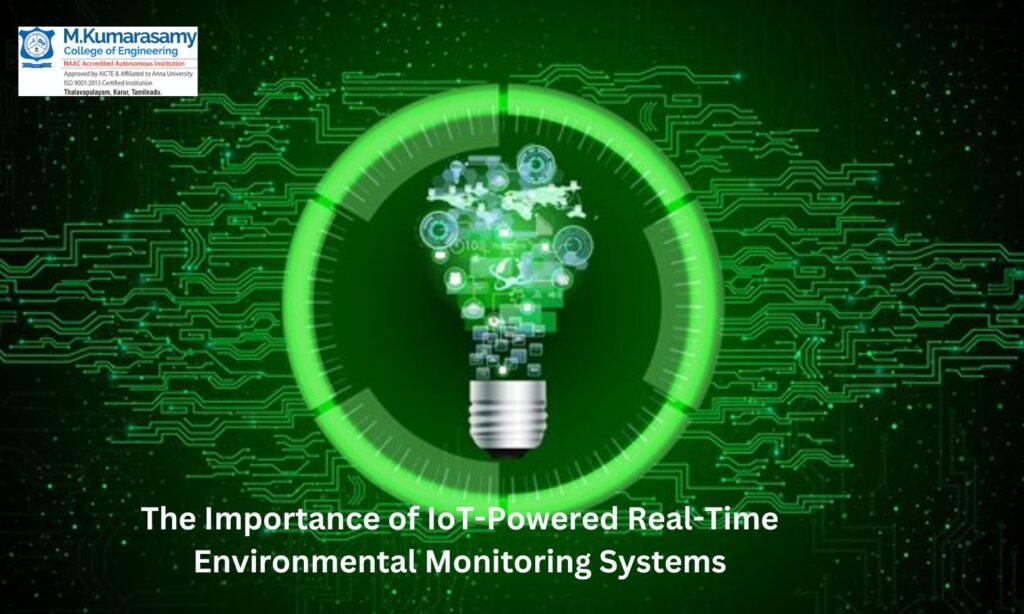Environmental concerns have reached critical levels globally, and therefore, humanity must deploy advanced solutions for monitoring and managing ecosystems. Moreover, the advent of IoT-powered Real-Time Environmental Monitoring Systems offers a transformative approach to addressing these challenges. At M.Kumarasamy College of Engineering (MKCE), this pioneering technology is integrated into the academic curriculum, preparing students to spearhead innovation in this domain.
Understanding IoT-Powered Real-Time Environmental Monitoring Systems

Real-Time Environmental Monitoring Systems harness the Internet of Things (IoT) to provide accurate, continuous, and actionable data. Consequently, these systems use interconnected sensors, gateways, and analytics tools to monitor environmental parameters like air quality, water purity, temperature, and humidity. Furthermore, with the ability to operate seamlessly, they empower stakeholders to take timely decisions.
Additionally, the deployment of IoT-powered Real-Time Environmental Monitoring Systems transcends conventional methods by offering unprecedented precision and scalability. By integrating IoT into these systems, users gain access to live data streams, predictive analytics, and automated alerts, capabilities that are indispensable in combating environmental degradation.
Key Features and Functionalities
IoT-powered Real-Time Environmental Monitoring Systems boast several groundbreaking features:
- Continuous Data Acquisition: Sensors collect data every second, ensuring no lapse in environmental observation.
- Remote Accessibility: Real-time monitoring enables stakeholders to access data from anywhere globally, fostering proactive decision-making.
- Automated Alerts: Systems generate instant notifications when parameters exceed predefined thresholds, mitigating potential hazards.
- Predictive Analytics: Advanced algorithms analyze historical and current data to predict environmental trends.
- Energy Efficiency: Devices operate with low power consumption, ensuring sustainability while functioning continuously.
Consequently, these features make Real-Time Environmental Monitoring Systems indispensable in fields such as agriculture, urban planning, disaster management, and industrial regulation.
Real-World Applications
The versatility of IoT-powered Real-Time Environmental Monitoring Systems ensures their applicability across diverse sectors:
- Urban Air Quality Management: For example, smart cities deploy these systems to monitor pollutants and enforce pollution control measures.
- Water Resource Management: Furthermore, sensors detect contamination levels in real-time, ensuring the safety of drinking water supplies.
- Agriculture: Farmers utilize these systems to monitor soil moisture, temperature, and pest activity, thereby optimizing crop yield.
- Disaster Preparedness: Moreover, environmental monitoring systems alert authorities about potential natural disasters like floods and forest fires.
- Industrial Compliance: Factories implement these systems to adhere to environmental regulations and reduce carbon footprints.
Advantages Over Conventional Methods
The IoT-powered Real-Time Environmental Monitoring Systems eclipse traditional methodologies through their dynamic capabilities. Unlike static monitoring methods, IoT-driven systems offer:
- Precision: Enhanced sensor accuracy eliminates errors inherent in manual data collection.
- Speed: Instantaneous data transmission accelerates response times during crises.
- Cost-Effectiveness: Automated systems reduce the need for extensive manpower and infrastructure.
- Scalability: These systems adapt to varying scales, from local ecosystems to global monitoring networks.
Technological Framework
Real-Time Environmental Monitoring Systems rely on cutting-edge IoT technology, comprising the following components:
- Sensors: Devices that measure environmental parameters with high sensitivity.
- Communication Networks: For instance, technologies like LoRa, Zigbee, and 5G ensure seamless data transmission.
- Cloud Platforms: Centralized systems store and process vast datasets for real-time insights.
- Dashboards: User-friendly interfaces visualize data, thereby enabling quick interpretation.
- Machine Learning Algorithms: These enhance the predictive and adaptive capabilities of the systems.
Role of MKCE in Advancing This Technology
M.Kumarasamy College of Engineering recognizes the transformative potential of Real-Time Environmental Monitoring Systems. As a result, by integrating this technology into its curriculum, MKCE equips students with the knowledge and skills to excel in IoT-driven environmental solutions.
Furthermore, MKCE emphasizes practical learning, offering students hands-on experience in designing and deploying IoT-powered Real-Time Environmental Monitoring Systems. In addition, the institution’s collaboration with industry leaders ensures that students remain at the forefront of technological innovation.
Future Prospects
The future of Real-Time Environmental Monitoring Systems appears promising, with emerging trends enhancing their efficiency and impact. For instance, Artificial Intelligence (AI) integration will enable predictive maintenance, while blockchain technology will ensure data integrity. Additionally, advancements in sensor technology and energy harvesting will make these systems more sustainable and accessible.
As the demand for IoT-powered Real-Time Environmental Monitoring Systems grows, the need for skilled professionals intensifies. Accordingly, institutions like MKCE play a pivotal role in meeting this demand by nurturing future innovators.
Conclusion
IoT-powered Real-Time Environmental Monitoring Systems stand as a beacon of hope in addressing global environmental challenges. By combining real-time data, predictive analytics, and automation, these systems revolutionize the way we perceive and protect our environment. Therefore, M.Kumarasamy College of Engineering’s commitment to fostering expertise in this field underscores the importance of education in shaping a sustainable future. Moreover, the fusion of technology and academia ensures that we remain prepared to tackle environmental concerns with ingenuity and resilience.
Real-Time Environmental Monitoring Systems are not just technological marvels; instead, they are catalysts for a greener, smarter, and more sustainable world.

